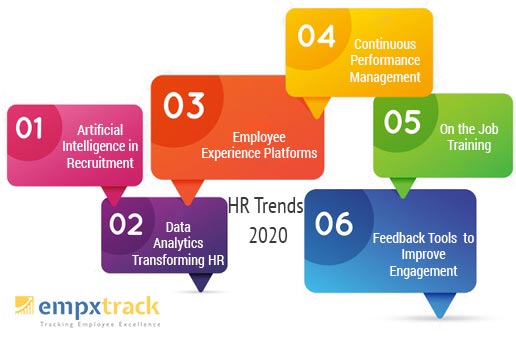This post highlights emerging top 8 global HR trends 2020 that you should know before heading into the next year.
Latest Update – Future global HR trends for 2024 are also out, and you may read them to know what the future of HR may look like.
As we near the end of this year, it’s time to watch out for emerging HR trends in 2020. According to Forrester, more than 47% of interviewed executives believe that by 2020, technology will have an impact on more than half of their sales as well as the future workplace trends.
Organizations will focus on embracing HR technology to their advantage, strengthening workforce capabilities, ensuring data security, improving candidate and employee experiences, and more.
Emerging HR trends in 2020

-
Artificial Intelligence in Recruitment
In the year 2020, AI-driven solutions will provide immense innovation in industries including Banking, Finance, Manufacturing, Retail, Healthcare, Transportation, Social Media, etc. Organizations will adopt AI and use it in recruitment and hiring processes. AI-powered solutions will rule in the year ahead with the following advantages.
Time saving – Chatbots, considered as the dream assistant, are the conversational interface platforms that save time and speed up the recruitment process by answering the most common questions of the applicants. AI will minimize repetitive tasks, hence enabling organizations to make hiring decisions faster and improve candidate experience.
Faster candidate screening – Screening a large pool of applicants requires time and effort. For a single hire, candidate shortlisting and screening take up almost 23 hours of a recruiter’s time. AI powered recruitment solutions will help in filtering high volume of resumes and pre-qualifying candidates based on the job description and skills. Such solutions will be more in demand in the coming year as recruiters would be able to identify candidate’s personality traits and predict their suitability for a job role. This would not only reduce the hiring efforts but also encourage unbiased candidate assessment.
Quality hiring – With unbiased screening and selection of candidates through AI,the quality of hires will improve and organizations would see a more productive and talented workforce in the coming year.
Data Analytics Transforming HR
Data analytics will continue to be adopted rapidly in the year ahead. Using analytics, data driven decisions can be made by HR professionals to attract and retain top talent.
The coming year will provide endless possibilities to use analytics in identifying trends and patterns on employee absenteeism, leave frequency, employee turnover rate, engagement level etc. Data analytics will play a prominent role in:
- Implementing best, proven recruiting practices
- Reducing employee turnover
- Increasing employee experience and satisfaction
- Managing task automation and process improvement
- Increasing workforce productivity and engagement
- Improving workforce planning and talent development
-
Employee Experience Platforms
Today, employees expect a lot more than just good pay and an ideal work environment. Employees do not hesitate to review and rate their company culture, work policies, growth opportunities, compensation and more on employment review websites like Glassdoor, Indeed, etc.
Employees share their experiences on these platforms publicly that can impact the reputation of their company.
Thus, improving employee experience is the need of the hour. Global HR experts suggest taking help of advanced HR technology solutions to enhance employee experience.
With the rapid digital transformation, multiple HCM platforms have come up in the market, yet there are very few which provide the desired employee experience. These enterprise HR solutions are highly customizable and configurable, yet lack in employee engagement and development capabilities.
The year 2020 will see a shift of focus to employee experience platforms (EXP).
As stated by Josh Bersin in a report, “The EXP is a single place to design, manage, and measure all employee interactions across the company. These platforms would dramatically reduce the cost and time spent on developing custom employee portals, integrating back-end systems, validating security, and measuring service interactions across multiple backend systems.
The Employee Experience Platform lets a company design multi-step, multi-flow experience, integrate it with all IT and HR applications, and abstract the user from the complexity behind the scenes.”
He further adds that, “EXP serves as a destination for employees — a place to find answers, collaborate, and share information – as well as a set of tools to create and manage cases, direct queries to the right person or group, and develop insights over time.”
The EXP will provide an integrated solution to manage coaching, career development, benefits administration, onboarding, performance management and payroll on a single platform, in an intuitive manner.
With the evolution of EXP in the upcoming years, we will see a dramatic shift in the way organizations embrace technology and manage processes to empower employees.
-
Continuous Performance Management
The approach of once-in-a-year feedback and reviews is long gone.
Organizations have gone through a huge transformation in performance management hoping to achieve high productivity, improved employee engagement and talent retention.
As a software provider and industry insider, we realized this when interacting with over 200 global organizations in 2019. Organizations are investing in Continuous Performance Management (CPM) tools to streamline their company processes in a better way and empower employees.
Tushar Bhatia, CEO of Empxtrack said, “The key challenge in a traditional review process is that feedback is provided to employees at the end of the year or at specific pre-ordained timelines. This does not work for employees, and in many ways is detrimental to employee morale.
Continuous Performance Management encourages periodic interaction between the employee and the manager allowing course-correction, timely feedback, coaching and development opportunities based on business needs. Productivity can go up by as much as 15% by implementation of the CPM processes.”
In 2020, adoption of CPM processes is expected to grow expansively. HR software vendors, like Empxtrack, are already offering CPM tools to encourage a work culture where continuous coaching and mentoring, constructive feedback, holistic reviews, skill development plans, unbiased praise and recognition are prevalent.
-
On the Job Training
Employees require continuous mentoring, training and skill development to perform well in their jobs. Continuous learning improves employee skills, making employees more adaptive to the work environment and preparing them to take up different roles in their company.
The year 2020 will see organizations investing in Virtual and augmented reality, gamification, geofencing, and other techniques to impart on-the-job training to their workforce.
Feedback Tools to Improve Engagement
Organizations will move forward with well-thought strategies to improve workforce engagement through HR technology innovations.
The emerging HR trends in 2020 will encourage use of employee engagement tools and survey platforms to capture employee opinions and feedback. To further augment these engagement strategies, incorporating advanced tools like VEED’s Video-to-Text can transform employee feedback sessions. By converting video feedback into text data, organizations can analyze and derive actionable insights more effectively, streamlining the feedback process and enhancing engagement through innovative technology solutions.
Employee satisfaction surveys would help you to connect with your employees and promote engagement and profitability. These feedback tools will help management understand employee concerns and take corrective action plans to retain the best talent.
Final Thought
Each year, global HR leaders come up with predictions on emerging HR trends. Their predictions are based on an entire year’s study and analysis on human resource practices and evolving technology.
Though trends may come and go, don’t make an uninformed decision to follow these blindly. Experts suggest that HR should study yearly predictions, analyze what works best for their organization, and then implement these in a phased manner.
If there are any more trends that you would like to add to the list of these emerging HR trends in 2020, please share your thoughts in the comments below.
A self-service portal at no cost
Conduct appraisals at no cost
Conduct 360 feedback at no cost
* No credit card required









Awesome blog. I enjoyed reading your articles. This is truly a great read for me. I have bookmarked it and I am looking forward to reading new articles. Keep up the good work!
Thanks for sharing such an informational blog which will, surely be a big help to the small medium enterprise so that they can choose the best suited tool for their business.
Best source of knowledge